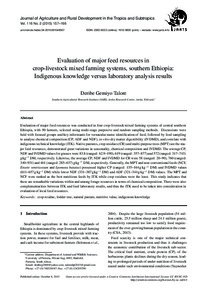| dc.date.accessioned | 2015-10-26T13:44:21Z | |
| dc.date.available | 2015-10-26T13:44:21Z | |
| dc.date.issued | 2015-10-08 | |
| dc.identifier.issn | 1612-9830 | |
| dc.identifier.issn | 2363-6033 | |
| dc.identifier.uri | urn:nbn:de:hebis:34-2015061048507 | |
| dc.identifier.uri | http://hdl.handle.net/123456789/2015061048507 | |
| dc.language.iso | eng | |
| dc.publisher | Kassel University Press | ger |
| dc.rights | Urheberrechtlich geschützt | |
| dc.rights.uri | https://rightsstatements.org/page/InC/1.0/ | |
| dc.subject | crop residue | eng |
| dc.subject | fodder tree | eng |
| dc.subject | natural pasture | eng |
| dc.subject | nutritive value | eng |
| dc.subject | indigenous knowledge | eng |
| dc.subject.ddc | 630 | |
| dc.title | Evaluation of major feed resources in crop-livestock mixed farming systems, southern Ethiopia: Indigenous knowledge versus laboratory analysis results | eng |
| dc.type | Aufsatz | |
| dcterms.abstract | Evaluation of major feed resources was conducted in four crop-livestock mixed farming systems of central southern Ethiopia, with 90 farmers, selected using multi-stage purposive and random sampling methods. Discussions were held with focused groups and key informants for vernacular name identification of feed, followed by feed sampling to analyse chemical composition (CP, ADF and NDF), in-vitro dry matter digestibility (IVDMD), and correlate with indigenous technical knowledge (ITK). Native pastures, crop residues (CR) and multi-purpose trees (MPT) are the major feed resources, demonstrated great variations in seasonality, chemical composition and IVDMD. The average CP, NDF and IVDMD values for grasses were 83.8 (ranged: 62.9–190), 619 (ranged: 357–877) and 572 (ranged: 317–743) g kg^(−1) DM, respectively. Likewise, the average CP, NDF and IVDMD for CR were 58 (ranged: 20–90), 760 (ranged: 340–931) and 461 (ranged: 285–637)g kg^(−1) DM, respectively. Generally, the MPT and non-conventional feeds (NCF, Ensete ventricosum and Ipomoea batatas) possessed higher CP (ranged: 155–164 g kg^(−1) DM) and IVDMD values (611–657 g kg^(−1) DM) while lower NDF (331–387 g kg^(−1) DM) and ADF (321–344 g kg^(−1) DM) values. The MPT and NCF were ranked as the best nutritious feeds by ITK while crop residues were the least. This study indicates that there are remarkable variations within and among forage resources in terms of chemical composition. There were also complementarities between ITK and feed laboratory results, and thus the ITK need to be taken into consideration in evaluation of local feed resources. | eng |
| dcterms.accessRights | open access | |
| dcterms.bibliographicCitation | In: Journal of Agriculture and Rural Development in the Tropics and Subtropics. Kassel : Kassel University Press. - Vol. 116, No. 2 (2015), S. 157-166 | |
| dcterms.creator | Talore, Deribe Gemiyo | |
| dc.description.everything | Gedruckte Ausg. im Verlag Kassel Univ. Press (www.upress.uni-kassel.de) erschienen. | ger |

